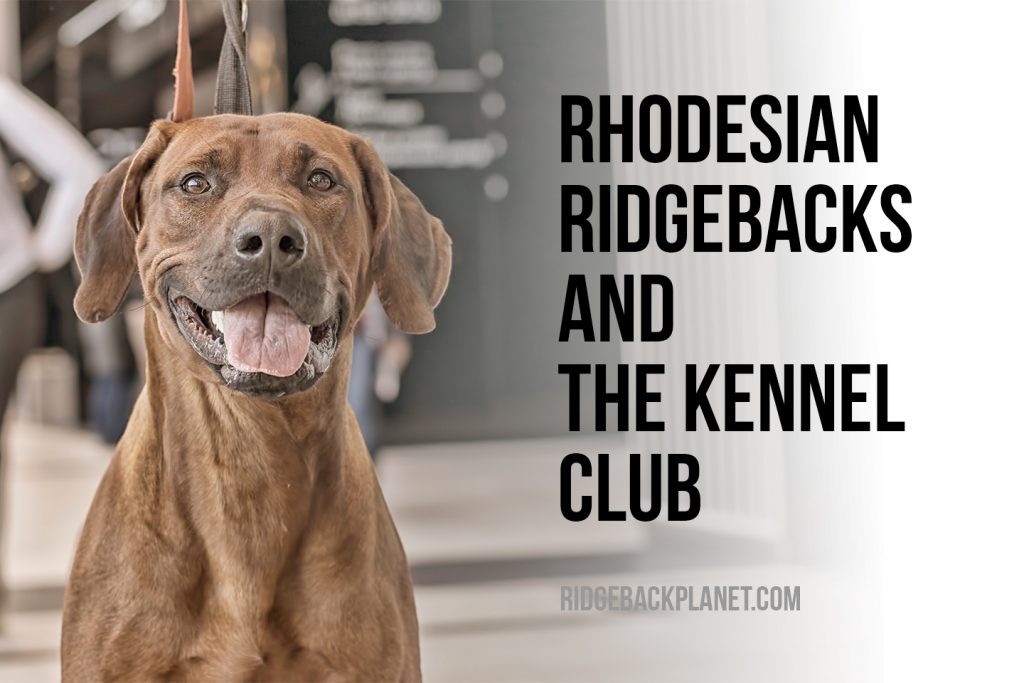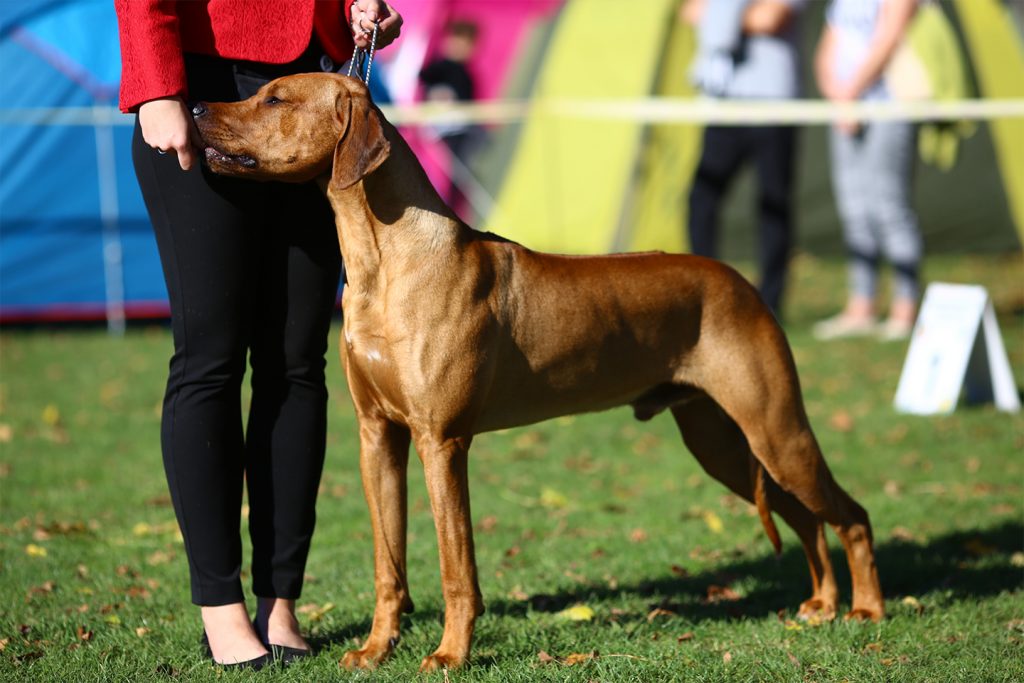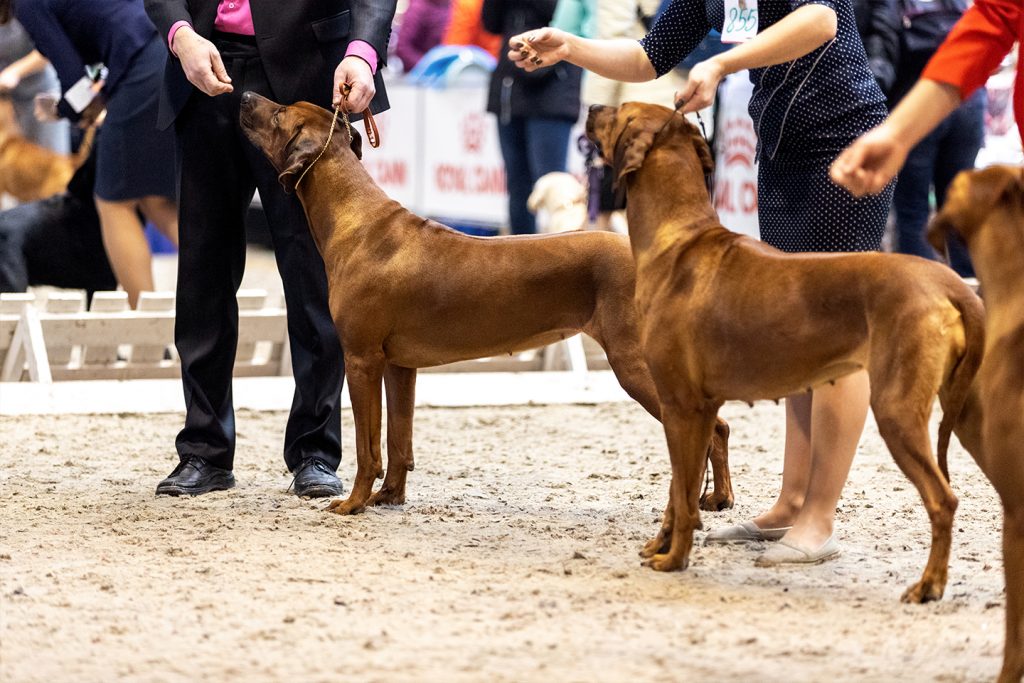5 Things to Know Before Getting a Rhodesian Ridgeback

To ensure getting healthy puppy you will need to look into reputable breeders, and what better place to find them than within the American Kennel Club?

If you are considering adding a Rhodesian Ridgeback to your family, there is a high chance you have been looking into where to source one from. After all, you definitely want a puppy that is healthy and comes from excellent quality breeding stock. To ensure this you will need to look into reputable breeders, and what better place to find them than within the American Kennel Club?
It’s unlikely that as a dog lover and prospective dog owner you haven’t heard of the Kennel Club of America. However, your knowledge of this organization may not extend much further than that. This is something that we need to change, especially if you’re considering owning a purebred Rhodesian Ridgeback. So without further ado…….
Bringing Dog Lovers Together
According to the American Kennel club ‘being a dog lover is not a pastime, it’s a way of life.’ A sentiment that I’m sure we would all agree with, and that the Kennel Club lives by. They are America’s leading authority on all things dog, including Rhodesian Ridgeback, and a premier resource for all dog lovers. This includes information on breeding to training and everything in between. At a glance the American Kennel Club:
- Is the world’s oldest and largest not for profit all breed registry with more than 180 recognized breeds
- Has more than 5000 affiliated organizations and member clubs including the Rhodesian Ridgeback Club of the United States
- Holds more than 22,000 events per year, including sporting, with over 3 million entrants
- Attracts more than 7 million visitors to its website every month
- Allocates millions of dollars to canine health research
- Runs one of the largest networks of dog rescue groups in America with more than 450
- Runs a micro-chipping program that has resulted, so far, in over 460,000 dogs being reunited with their owners
- Has a museum that is home to the largest collection of canine art in America
- Has a library that is the most comprehensive collection of books etcetera on the subject of domestic dogs
A Brief History Of The American Kennel Club
With a history that goes back nearly 135 years, the American Kennel Club has a long and distinguished career in all things dog related. Not only have they managed to build up a vast and unquestionable knowledge, however, but they have also done some amazing and life-changing things. A brief timeline of their history and achievements would include:
- September the 17th, 1884 – The first meeting of the American Kennel Club is held. Constitutions, by-laws, and dog show rules are created.
- 1889 – The first issue of the American Kennel Club Gazette is published. It is now one of the oldest dog magazines in existence.
- 1914 – The American Kennel Club overturns a New York City ordinance that all dogs should be muzzled in public.
- 1929 – The first edition of ‘Pure-bred Dogs is published. Nine years later it was renamed ‘The Complete Dog Book’ and has sold more than 2 million copies to date.
- 1939-44 – The American Kennel Club works alongside ‘Dogs for Defence’ which aimed to mobilize dog owners to donate quality animals. These dogs were then trained to work alongside and help military troops.
- 1948 – The Kennel Club takes over the running of Crufts which began in 1891.
- 1956 – The 5 millionth dog is registered with the American Kennel Club. A glorious Collie named Lassie the Golden Glory.
- 1981 – The 25 millionth dog is registered with the American Kennel Club. A gorgeous Scottish Terrier named Belgairs Duke of Rock Hill.
- 1984 – The American Kennel Club celebrates its centennial year by holding a dog show in Philadelphia. A German Shepherd, not Rhodesian Ridgeback, unfortunately, grabbed the ‘best in show’ title.
- 1994 – The sport of agility is established within the American Kennel Club. Rhodesian Ridgebacks love agility training.
- 2008 – The American Kennel Club supports the Georgia signing of anti-dog fighting legislation. This meant that it was a felony to own a dog for fighting, bet on a dog fight, or to allow a dog to fight on your premises.
- 2017 – The American Kennel Club is named as the number one content site for all things dog. (According to ComScore)
Enter The Rhodesian Ridgeback
In 1925, Francis Richard Barnes was responsible for a breed standard being set for the Rhodesian Ridgeback. He did this under the Eskdale Kennel banner when he arranged for 20 examples of the Rhodesian Ridgeback to be examined. This took place at a breeders symposium where the best traits of this breed were determined.
After careful thought, and examination, the Rhodesian Ridgeback was placed into the hound category which included all breeds that assisted hunters by identifying the location of prey, and/or recovering it. A perfect category for the Rhodesian Ridgeback who located pests such as boar, monkeys, or lion, and held them at bay until their owners arrived.
Perhaps surprisingly, or not, to those who have studied the history of the Rhodesian Ridgeback, the symposium where the breed standard was decided upon had nothing to do with the Kennel Club of America. In fact, this wonderful breed did not even make it onto American soil until 1950. Rather, this symposium was held in Africa.
When the Rhodesian Ridgeback did make it to American Shores it was Mr. and Mrs. William O Brien who took six to live in Arizona. It would, however, be another five years before they would be admitted to the American Kennel Club as an accepted breed. They were put into the hound group as they had been in Africa, and the breed standard used was the same. The first Rhodesian Ridgeback registered with the American Kennel Club was Tchaika of Redhouse in 1955.
The Rhodesian Ridgeback Breed Standard
The breed standard for the Rhodesian Ridgeback has remained virtually unchanged since Francis Richard Barnes first established it in 1925. As previously stated this breed falls into the hound category and is listed by the American Kennel Club as ‘affectionate, dignified, and even-tempered.’
The actual ‘breed standard’ itself is pages long and probably only of great importance to those who show and breed. The American Kennel Club has, however, given an abbreviated version of the breed standard which is as follows:
The Rhodesian Ridgeback represents a strong, muscular, and active hound, symmetrical and balanced in outline. A mature Rhodesian Ridgeback is a handsome, upstanding, and athletic dog, capable of great endurance with a fair (good) amount of speed. Of even, dignified temperament, the Rhodesian Ridgeback, is devoted and affectionate to his master, reserved with strangers. The peculiarity of this breed is the ridge on the back. The ridge must be regarded as the characteristic feature of the breed.
How The Kennel Club Can Help You With Your Rhodesian Ridgeback
Though it’s always advisable to use as many reliable sources as possible to research, the American Kennel Club is undoubtedly a great place to start when it comes to the Rhodesian Ridgeback. They have a plethora of information, both specifically breed related, and some not.
Breed Specific
- About – If you are considering getting yourself a Rhodesian Ridgeback you need to research and learn as much as you can about them. The ‘about’ section on the American Kennel Club website will help you do this.
- Features – Every dog breed has its own set of physical features that distinguish it from others. The ‘features’ section shows you these using both video and images.
- History – Being aware of the history of the Rhodesian Ridgeback can help you understand the dog that they have become today. This section provides a concise but comprehensive timeline of the breed.
- Puppy Finder – A section that will help you find a Rhodesian Ridgeback breeder close to you that is American Kennel Club approved. By selecting a breeder from this section you can ensure that your prospective puppy has been bred ethically and within health guidelines.
- Care – All dog breeds have specific care needs relating to nutrition, grooming, exercise, training, and health. In this section, you can read all about the Rhodesian Ridgeback care needs.
- Did You Know – Quick bites of information related to the Rhodesian Ridgeback. Such as; did you know that one of the first breeders of the Rhodesian Ridgeback was the actor Errol Flynn. He bred them on his ranch in the 1930s but sadly the bloodline has since become extinct
- Standard – This is a comprehensive guide to the standards a Rhodesian Ridgeback needs to meet for the Kennel Club. This includes things like height, weight, color, and appearance.
- Other Breeds To Explore – Suggestions of other dog breeds you may wish to consider along with, or instead of the Rhodesian Ridgeback. This breed is not suitable for everybody but others suggested may be.
Non-Breed Specific
- Expert Advice – Everything from breeding to lifestyle, to health, home and living, and training
- Products and Services – Dog treats, training schools, doggy gift packs, breed specific products, and grooming services
- Sports and Events – A calendar of shows, agility, obedience, and tracking competitions
- Clubs and Delegates – Clubs affiliated with the American Kennel Club that you may wish to join or use for additional research and resources such as the Rhodesian Ridgeback Club of the United States
Crufts – The Kennel Clubs Most Famous Show

Undoubtedly the Kennel Club is most famous for the amazing array of shows and events that it puts on every year; the most famous being Crufts. This is run by the UK branch of the Kennel Club but attracts competitors and their dogs from all over the world. It is a show that not only displays the ultimate canines of the world but also celebrates every aspect of the role that our dogs play in our day-to-day lives.
Established in 1891 by Charles Cruft who was a well-known showman, Crufts quickly became a popular event. It was taken over by the Kennel Club in 1948, and though it has since changed in many ways, still remains an essential date in any dog lovers calendar. The ultimate prize here, coveted by every entrant, is the ‘best in show’ trophy.
Over the years that Crufts has been running, here comes some fascinating facts, there has been:
- 128 years of competition; that’s 896 in dog years
- 80 best in show champions
- 43 different breeds taking best in show
- 8 Cocker Spaniels taking best in show
- Approximately 160,000 people attending; so many to lick
- Over 2995 overseas entrants every year
- 46 different countries entering every year
- One dog pooping live on TV
The Rhodesian Ridgeback And Crufts

Since the Rhodesian Ridgeback has only been a Kennel Club recognized breed since 1955 it has only competed at Crufts a maximum of 64 times. Unfortunately, during this time it has never taken ‘best in show’ which is surprising for such a handsome and dignified breed.
There are seven groups into which all the breeds competing are divided into. These are gundog, working, pastoral, toy, utility, terrier, and hound. The Rhodesian Ridgeback falls under hound which is described as ‘originally being used for hunting either by scent or by sight. The scent hounds include the Beagle and Bloodhound and the sighthound’s such breeds as the Whippet and Greyhound. Many of them enjoy a significant amount of exercise and can be described as dignified, aloof but trustworthy companions.’ Other breeds in this group include Foxhound, Greyhound, Irish Wolfhound, Saluki, and Beagle.
A Word Of Warning
It would be irresponsible not to mention in an article that talks about both the Kennel Club and Crufts the concerns some hold over pedigree breeding and breed standards. For example, in 2016 a German Shepherd named Cruaghaire Cairo was awarded the Crufts best of breed title much to many onlookers dismay. Why? Because this German Shepherd displayed an abnormally sloped back which had led it to move with an unusual and possibly unhealthy gait.
Prior to the show and also during the show, the Kennel Club veterinarians had deemed Cruaghaire Cairo as a fit and healthy specimen of the German Shepherd breed. However, after the show, when people reacted in horror, they reversed this decision and announced plans to look into the claims that some of their approved breeders were producing deformed breeds in an attempt to meet their standards.
This occurrence at Crufts has led to a lot of discussion about ‘breed standards’ and peoples pursuance of them. It has become an acceptable part of breeding, for example, to want to only breed from dogs which have been Crufts champions. This leads to what is known as the ‘popular sire syndrome’ where champions are bred with champions and the gene pool becomes narrower and narrower.
Generally speaking, a healthy breed is one that has a great deal of diversity, meaning that narrow gene pools can be a huge problem. Genetic diseases are easily passed through a narrow gene pool, and traits that are desirable can become more and more exaggerated to the point where they are a risk to the health of a breed.
Exaggerated desired traits are a huge factor when it comes to choosing a Rhodesian Ridgeback. Remember that the Kennel Club breed standard classes the ridge on their back as their most distinguishing and important feature. In fact, Rhodesian Ridgebacks without a ridge will be disqualified from the competition.
This means that certain breeders may be trying to emphasize and exaggerate the ridge even more, which could prove to be disastrous for the Rhodesian Ridgeback. After all, they are well known to develop dermoid sinus which is not easy to treat and can even cause the death of your beloved dog.
All this does not mean that pedigree dogs, or dogs sourced through the Kennel Club, are a bad idea, as they certainly aren’t. However, it does mean that you need to be cautious and ensure that the breeder you choose is breeding healthy puppies, and not ones that are being pushed to extremes.
A Quick Word On Dermoid Sinus
Also known as a pilonidal sinus, a dermoid sinus is a tubular skin defect that is caused by incomplete separation of the skin and nervous system during embryonic development. The sinus can be found at any point along the back or neck, but most commonly affects the upper neck and spine. The depth of the defect varies, the tube:
- may go into the tissue just beneath the skin
- may go deeper and attach to the membrane covering the spinal cord
- may be a blind-ended sac underneath the skin
Dermoid sinus is most common in the dog breed the Rhodesian ridgeback, in which it is congenital and heritable. Affected pets should not be bred.
A dermoid sinus can be recognized in Rhodesian Ridgebacks of a young age as an opening on the midline of the back with protruding hair, often in a swirl. A tube or cord may be felt beneath the opening though some dermoid sinuses may not be associated with any clinical signs. Sinuses that become plugged with keratin debris can become infected and an abscess can form.




















